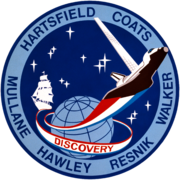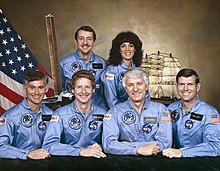STS-41-D

The launch of Space Shuttle Discovery on its first mission on 30 August 1984.
|
|||||
| Mission type | Satellite deployment | ||||
|---|---|---|---|---|---|
| Operator | NASA | ||||
| COSPAR ID | 1984-093A | ||||
| SATCAT № | 15234 | ||||
| Mission duration | 6 days, 56 minutes, 5 seconds | ||||
| Distance travelled | 4,010,000 kilometres (2,490,000 mi) | ||||
| Orbits completed | 97 | ||||
| Spacecraft properties | |||||
| Spacecraft | Space Shuttle Discovery | ||||
| Launch mass | 119,511 kilograms (263,477 lb) | ||||
| Landing mass | 91,478 kilograms (201,674 lb) | ||||
| Payload mass | 18,681 kilograms (41,184 lb) | ||||
| Crew | |||||
| Crew size | 6 | ||||
| Members |
Henry W. Hartsfield, Jr. Michael L. Coats Richard M. Mullane Steven A. Hawley Judith A. Resnik Charles D. Walker |
||||
| Start of mission | |||||
| Launch date | 30 August 1984, 12:41:50 UTC | ||||
| Launch site | Kennedy LC-39A | ||||
| End of mission | |||||
| Landing date | 5 September 1984, 13:37:54 UTC | ||||
| Landing site | Edwards Runway 17 | ||||
| Orbital parameters | |||||
| Reference system | Geocentric | ||||
| Regime | Low Earth | ||||
| Perigee | 346 kilometres (187 nmi) | ||||
| Apogee | 354 kilometres (191 nmi) | ||||
| Inclination | 28.5 degrees | ||||
| Period | 90.6 min | ||||
| Epoch | 1 September 1984 | ||||
|
|
|||||


Back row: L-R: Walker, Resnik
Front row L-R: Mullane, Hawley, Hartsfield, Coats
STS-41-D was the 12th flight of NASA's Space Shuttle program, and the first mission of Space Shuttle Discovery. It was launched from Kennedy Space Center, Florida, on 30 August 1984, and landed at Edwards Air Force Base, California, on 5 September. Three commercial communications satellites were deployed into orbit during the six-day mission, and a number of scientific experiments were conducted.
The mission was delayed by more than two months from its original planned launch date, having experienced the Space Shuttle program's first launch abort at T-6 seconds on 26 June 1984.
The launch was originally planned for 25 June 1984, but because of a variety of technical problems, including rollback to the Vehicle Assembly Building to replace a faulty main engine, the launch was delayed by over two months. The 26 June launch attempt marked the first time since Gemini 6A that a manned spacecraft had experienced a shutdown of its engines just prior to launch.
During the 26 June launch attempt, there was a launch abort at T-6 seconds, followed by a pad fire about ten minutes later.
...
Wikipedia
